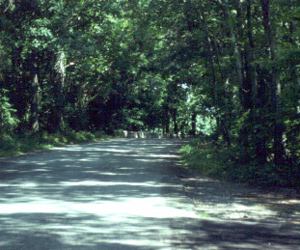
Natchez Trace
From the port of Natchez on the Mississippi River, the Natchez Trace followed over 500 miles of intertwining Indian paths through the Choctaw and Chickasaw nations across the Tennessee River to Nashville. For reasons of national security, Winthrop Sargent, first governor of Mississippi Territory, recommended in 1799 the opening of a post road from Natchez to Knoxville to improve communications with the nation’s capital. The administration and Congress concurred, but permission had to be obtained to cross Indian land. Though the Cherokees refused to allow a road from Knoxville to Nashville, in 1801 the Choctaws and Chickasaws agreed. Consequently Nashville became the northern terminus. Because the Chickasaws wisely reserved rights to operate houses of accommodation and ferries in their nation, some mixed-bloods such as George Colbert profited considerably from their businesses on the Trace.
Soon the Trace became heavily traveled by gold-laden boatmen returning to Tennessee, Kentucky, and points beyond after selling their cargoes and flatboats at New Orleans and Natchez. They were not alone. A vast assemblage of characters also marched the same route: robbers, rugged pioneers, fashionable ladies, shysters, politicians, soldiers, scientists, and men of destiny such as Aaron Burr, Andrew Jackson, and Meriwether Lewis.
Under the command of General James Wilkinson, Edmund Pendleton Gaines marked the path through the Indian nations in 1802, and over the next several years army troops widened the trace through the Natchez District for some 40 miles beyond, and then over the final 150 miles leading into Nashville. Because such “land pirates” as Samuel Mason and Joseph Thompson Hare infested the road in its early years, the myth of violence still shrouds the Trace. Micajah and Wiley Harpe are often associated with the Trace, but most of their mayhem took place in Kentucky and Tennessee. Though the number of robberies and murders on the Trace had subsided by 1805, most persons venturing on the Trace traveled in convoys. Although it was not unusual for outlaws to disguise themselves as Indians, Indians committed few serious crimes on the Trace; in fact, they often provided considerable assistance. Occasionally, however, they hid the horses of sleeping travelers and demanded ransom to find them.
From Natchez the Trace ran northward through the Natchez District to Bayou Pierre, east of Vicksburg. From there, it veered northeastward 160 miles through the Choctaw Nation to Line Creek and another 205 miles through Chickasaw territory to the Duck River ridge. The final segment ran through a sparsely settled portion of Tennessee into Nashville. Despite the improvements at each end, much of the Trace remained a horse path through the wilderness. The postmaster general contracted with businessmen to deliver the mail from Nashville to Natchez; in turn, they hired riders who made the trip in ten to fifteen days. John Lee Swaney is the only rider who escaped anonymity. With the founding of Columbia, Tennessee, in 1807, officials routed mail deliveries via the new town, and commercial traffic soon followed.
The Trace is best known as a commercial route by which the colorful boatmen, often young and unpolished, made their way back to their homes–generally after celebrations in New Orleans and/or Natchez. Mike Fink, a riverman mythologized by Mark Twain and others, remains the quintessential riverman–half alligator, half horse. Though at first there were only a few houses of accommodation scattered among the Chickasaws, soon they dotted the Trace from end to end.
Tennessee militia used the Trace on at least three occasions. In 1803 the secretary of war ordered troops to Natchez as a precaution during the transfer of Louisiana. In 1813 John Coffee led the cavalry to rendezvous with Andrew Jackson and the militia infantrymen who arrived in Natchez on boats during the War of 1812. When Jackson received orders to dismiss his militiamen instead, he defiantly walked up the Trace with his men in a display of toughness that led to his sobriquet “Old Hickory.” Following the battle of New Orleans in 1815, Tennesseans, including the triumphant Jackson, returned up the Trace. Jackson, who first ventured to Natchez while it was under Spanish rule, by then was quite familiar with the road.
On October 11, 1809, thirty-five-year-old Meriwether Lewis met his untimely and mysterious death at Grinder’s Stand, 73 miles south of Nashville. The demise of Lewis was reported to Thomas Jefferson as a suicide, and this interpretation was not challenged until 1848, when Tennessee moved the site of his grave and constructed a monument over it that is now part of the Natchez Trace Parkway. In 1996 a group of forensic scientists convinced a Lewis County coroner’s jury to request that Lewis’s body be exhumed in order to determine his cause of death, bringing further attention to the old controversy.
By the late 1820s the Trace was no longer a heavily traveled route from Natchez to Nashville. Though local traffic used segments for decades, the Trace fell victim to numerous forces such as the steamboat, construction of competing roads, and changing settlement patterns. By then, however, the Trace had served its crucial role in cementing the southwestern frontier to the young republic despite French, Spanish, and British threats, and the frontiersmen who traveled this wilderness artery contributed to a force later known as Manifest Destiny. In this sense, the Natchez Trace was a pathway to an empire.
Suggested Reading
Vardis Fisher, Suicide or Murder? The Strange Death of Governor Meriwether Lewis (reprint, 1993); John D. W. Guice, “A Fatal Rendezvous: The Mysterious Death of Meriwether Lewis,” The Journal of Mississippi History 57 (1995): 121-38



